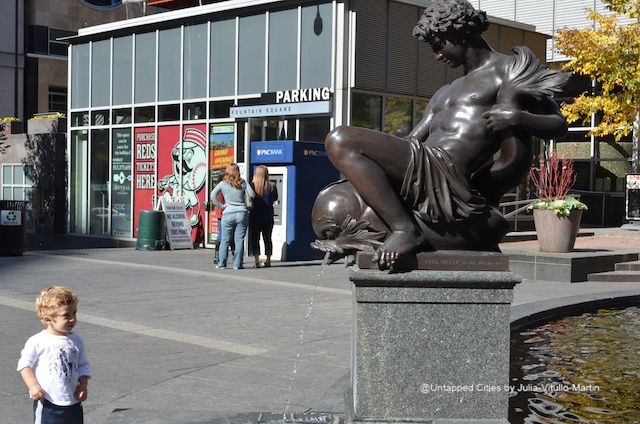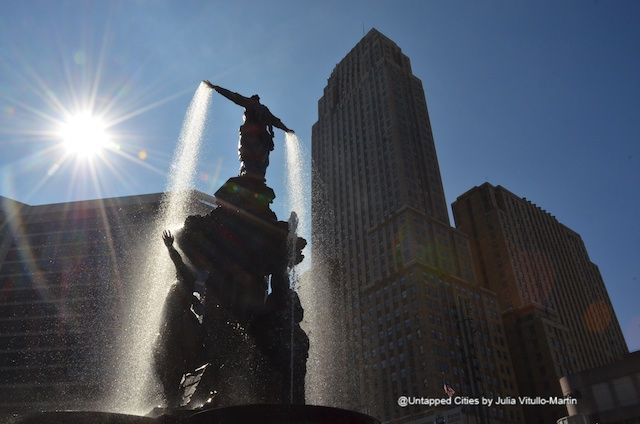Last Chance to Catch NYC's Holiday Notalgia Train
We met the voices of the NYC subway on our nostalgia ride this weekend!



How fabulous was Cincinnati in the old days? Winston Churchill, for one, thought it was sensational, and called it “the most beautiful of the inland cities of the union.” He singled out the “unsurpassed” Netherland Plaza Hotel from whose tower “the city spreads far and wide, its pageant of crimson, purple and gold laced by silver streams that are great rivers.” Over the top, of course, but so is downtown Cincinnati, mesmerizing in all its architectural splendor.
Yet Cincinnati is generally not on anyone’s list of the most-dazzling cities, partly because deindustrialization hit it so hard after World War II-and partly because it responded to its declining fortunes by implementing every known bad planning idea of the 20th century. Today Cincinnati is undergoing a renaissance that combines aggressive historic preservation with an economic development strategy based on sports, culture, and food-all three deeply embedded in Cincy’s view of itself. “Come for Bengals, Stay for Hofbrauhaus,” suggested a recent Cincinnati USA promo.

Sited on the north bank of the Ohio River, facing Kentucky, downtown Cincinnati is topographically dramatic, with seven hills behind it and the Ohio at its feet. As a major commercial center from the late 19th century through much of the 20th, it benefited from proud corporate titans (and a few robber barons) who chose to erect magnificent buildings to reflect their worldly success. While many of these commercial buildings are in sad disrepair today, large numbers are being renovated and burnished for residential occupancy.
Carew Tower and the Netherland Plaza
Because we always stay at the Netherland Plaza, which is housed in the Carew Tower-Cincinnati’s Rockefeller Center-we begin our walking tours in that paragon of mixed-use development. Opened in 1931 as Cincinnati’s tallest building (49 stories), Carew originally held a 48-story office building, a department store, shopping arcade, 800-room hotel, restaurants, and a 750-car 28-story fully automated garage. Like a lot of futuristic ideas in the ’30s the automated garage apparently never really worked, but you can still see very cool remnants if you park in the Netherland.

You can get an excellent (and, at $2, inexpensive) view of the entire city from Carew’s observation deck-the hills and their distinctive neighborhoods in the distance, the sports stadia that drive Cincy’s weekend economy in the foreground on the river. You can also see down to Fountain Square, now both symbol and heart of the town’s resurgence.
The square hosts some 200 events a year-concerts, salsa dancing, ice skating, farmers markets, and food festivals. It is surrounded by pleasant, reasonably priced restaurants, such as the urbane Via Vite, where George Clooney ate while shooting Ides of March, and Nada, favored by Ryan Gosling. The Cincinnati Visitor Center, stocked with useful maps and booklets, is staffed by locals who actually know the city and can direct you most anywhere.

Yet successful as the square is today, its history helps explain where Cincy went wrong in the 70s, when the square was little more than a hostile open space imprisoned by concrete and skywalks.
Bad Ideas, Bad Results
Despite its good 19th-century bones, by the end of the 20th Cincinnati became a virtual architectural dig of bad planning ideas. Like most American cities after World War II, it had faced an enormous set of interlocking problems categorized as the urban crisis: declining jobs and tax base, middle-class flight, deteriorating infrastructure, racial conflicts, rising crime, redlining, etc. But in deciding to try to attract back those who had fled, it opted for the wrong tactics. Suburbanites loved their cars, so Cincinnati downgraded public transit while putting commuter traffic efficiency at the top of its priorities. It cooperated with federal highway designs that ripped a spaghetti network of highways throughout the city. It widened streets to handle more cars, converted its major arteries to one way, and built huge parking lots to accommodate drivers.

Almost as bad, it decided streets were unpleasant, and created a whole new system of walkways-skywalks-one flight up from street level to link 15 blocks of restaurants, hotels, offices, and stores. When first proposed by Cincinnati’s director of planning in 1957, the idea was to keep people out of the paths of cars, enabling traffic to move efficiently while pedestrians stayed safe. The City Council rejected skywalks three times before federal urban renewal funds proved too attractive to turn down. In 1971, the feds paid for a link connecting the convention center to Fountain Square. Over the next 20 years more links were built to form a 1.3-mile system downtown. Some proponents argued that skywalks allowed the city to mimic a suburban shopping mall, which was presumed to be good.

But as private owners grew disillusioned they demolished some links, adding a sense of gloom to what was already a perplexing system. The Business Courier says the walk connecting Riverfront Stadium to office towers was demolished in 2002, with other demolitions following. The most important was in 2006, when the city demolished the pedestrian bridge over 5th Street as part of its redevelopment of Fountain Square. Suddenly downtown–and certainly the square–looked brighter and happier. Urban Cincy has recorded the system in a convenient map.
A New Toolkit
John Alschuler, the New York-based chairman of HR&A Advisors who developed the 2003 Central City Plan, said Cincinnati had failed to address its structural decline by implementing, at great expense, “the classic toolkit of urban renewal-a convention center, an arts center, two stadiums. These were projects, not places, and they were wholly disconnected. People come in, go to a game, go home. Or, come in, go to a symphony, go home.” Cincinnati itself was not the destination, in part because despite spending tens of millions of dollars it had not rebuilt its core. No city, says Alschuler, can be better than its core. Individual projects, however good, will only succeed if there is an “urban framework” that people want to be in.

Thus, he championed a fairly controversial position-that Cincinnati should pull back from investing in the riverfront, important as that would eventually be, and executives of Procter & Gamble, Convergys, PNC Bank, Kroger, Federated, American Financial, etc-agreed, some of them somewhat apprehensively. The plan’s most obvious physical triumph is Fountain Square, which is today a festive place. The square was relandscaped to be pedestrian-friendly by the Olin Partnership of Philadelphia working together with Cooper Robertson & Partners from New York. Its severe center stage was removed. The adjoining skywalk was demolished. Every building facing the square was expected to have ground-floor restaurants with outdoor seating.
Still, one part of the plan didn’t really succeed: vibrant retail.
The truth is there’s almost no really good retail in downtown Cincy. Even Carew Tower, lovely as it is, has far too much vacant retail space. Downtown just does not yet have enough residents and visitors. And what demand there is tends to be lower-end–thus T. J. Maxx occupies the elegant space built for the Gidding-Jenny Department Store.
A tremendous amount of renovated residential loft and apartment space will soon be coming on line, but at the moment only some 10,000 people live downtown–not yet enough to patronize high-end stores.

Even the graceful Netherland Plaza has had to adjust to the new casual Cincinnati. For their semi-annual showdown with the Bengals in October, the Pittsburgh Steeler football team took three floors at the Netherland. The readily identifiable black-and-yellow dressed Steeler fans were quietly roped off by security in front of the hotel, where everyone seemed to have a good time. A few pretty girls who knew to dress more formally made it to the elevators. “Oh,” said one to the huge man blocking the elevator exit on the Steeler floor, “what do you do for the team?” “I’m their babysitter,” he said. “Let me escort you back to the lobby.” They all went quietly. Downtown businesses are oriented to keeping everyone happy, which works reasonably well.
Sports fans have a different style from the Fred-and-Ginger days of the 30s, but they keep the downtown hotels, restaurants, and bars full on game weekends. They even show up at Cesar Pelli’s urbane Aronoff Center for the Arts, three blocks from Carew. “A little art isn’t going to kill you,” said a dad to his three Bengal-clad children at the entrance. “First we do the art. Then we eat. Then we go to the game.”
A multi-cultural weekend, Cincinnati-style.
Next: Over-the-Rhine, Cincinnati’s most historic neighborhood, home to the largest collection of Italianate architecture in the country–but, until recently, submerged by crime.
Subscribe to our newsletter